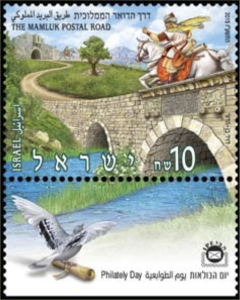December 2015
 The Postal Road established by the Mamluk Empire in Eretz Israel (1260-1516) ran from the capital in Cairo to the capital of the north – Damascus and other important centers. This main route and its branches served as a means of passing news between the outlying areas of the Empire and the capital.
The Postal Road established by the Mamluk Empire in Eretz Israel (1260-1516) ran from the capital in Cairo to the capital of the north – Damascus and other important centers. This main route and its branches served as a means of passing news between the outlying areas of the Empire and the capital.
The road from Egypt, which passed through the northern Sinai Desert, forked into two branches in Gaza – one toward Karak in Jordan via Beit Guvrin and Hebron and the other toward Damascus via Jitin (Ge’a), Qatra (Gedera), Ludd, Jinin, Baysan (Beit She’an), etc.
The Mamluk postal network was based on three components: equestrian post, homing pigeons and fire/smoke signals. This system was called Barid. The land Barid utilized fast horses whose sole purpose was to transport messages from the Sultan in Cairo. The messengers who rode these horses were selected from among those closest to the ruler.
The fourth Mamluk Sultan, al-Zahir Baybars al- Bunduqdari (1260-1277), who established the Mamluk Empire, reintroduced the Barid and incorporated it into his military structure. The peak of the Barid was during the third reign of al-Nasir Muhammad ibn Qalawun (1310-1341).
This postal system was based on stations positioned at regular intervals along the route where messengers were able to obtain fresh horses. Approaching messengers were recognized by station personnel based on identifying marks such as a yellow silk scarf tied to the messenger’s neck, a large silver medallion hanging from the messenger’s neck or a horse with a tied tail – and were met with a fresh horse so they could continue immediately on their journey.
It took no more than four days for the post to reach Damascus from Cairo.
In order to minimize the obstacles en route, Baybars built and repaired bridges. This Sultan’s hallmark – the lion/cheetah – appears on many of his buildings (and also on the stamp) and it decorated at least two of the bridges that he built: one near Cario and the other the Gandas Bridge near Lod which was one of the main stations along the Barid.
The Mamluk Postal Road left its impression on Eretz Israel and a number of impressive ruins from that network attest to its importance as a key land bridge among various countries.
—Dr. Katia Cytryn-Silverman
Lecturer at the Institute of Archaeology and the Department of Islamic and Middle Eastern Studies, The Hebrew University of Jerusalem



